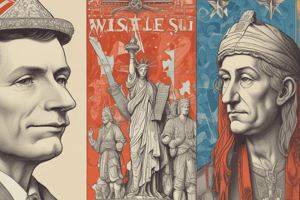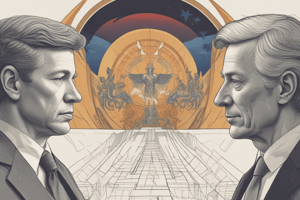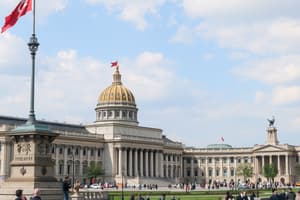Podcast
Questions and Answers
In a parliamentary system, what is the primary role of the head of state?
In a parliamentary system, what is the primary role of the head of state?
- To represent the country in ceremonial functions. (correct)
- To lead the day-to-day operations of the government.
- To be the head of the ruling party and its political strategy.
- To hold significant power, similar to a president.
What is a key characteristic that distinguishes a consensus democracy from a majoritarian democracy?
What is a key characteristic that distinguishes a consensus democracy from a majoritarian democracy?
- The existence of a strong, independent judiciary.
- The emphasis on broad participation and shared decision-making. (correct)
- The concentration of power in the hands of a single party.
- The use of referendums to decide major policy decisions.
Which of the following is NOT a consequence of a majoritarian system on the policy-making process?
Which of the following is NOT a consequence of a majoritarian system on the policy-making process?
- Policies can be implemented quickly due to fewer procedural hurdles.
- Policies often reflect a broad range of societal interests, ensuring stability. (correct)
- Policies may potentially lack long-term stability due to frequent changes in government.
- Policies may experience significant shifts with changes in government.
Which type of democratic system typically features a fixed interval for elections?
Which type of democratic system typically features a fixed interval for elections?
In a majoritarian system, how is power typically concentrated?
In a majoritarian system, how is power typically concentrated?
Which type of democracy is more likely to have a unitary and centralized government?
Which type of democracy is more likely to have a unitary and centralized government?
In a presidential system, the president is typically responsible for which of the following roles?
In a presidential system, the president is typically responsible for which of the following roles?
What is a key advantage of a consensus democracy in terms of policy-making?
What is a key advantage of a consensus democracy in terms of policy-making?
According to Aristotle's classification of regimes, what is the 'bad' form of government when ruled by one person?
According to Aristotle's classification of regimes, what is the 'bad' form of government when ruled by one person?
Which of the following best describes the 'substantive' view of democracy?
Which of the following best describes the 'substantive' view of democracy?
What are the two primary dimensions of democracy, according to Dahl?
What are the two primary dimensions of democracy, according to Dahl?
Which of the following is a core element of a procedural definition of democracy?
Which of the following is a core element of a procedural definition of democracy?
In ancient Greece, how were public officials typically selected?
In ancient Greece, how were public officials typically selected?
What is 'Politeia,' according to Aristotle's classification of regimes?
What is 'Politeia,' according to Aristotle's classification of regimes?
Which of the following best reflects a substantive evaluation of democracy in a country?
Which of the following best reflects a substantive evaluation of democracy in a country?
According to the content, which of these is a characteristic of a 'polyarchy'?
According to the content, which of these is a characteristic of a 'polyarchy'?
What is the core principle of a Westphalian state system?
What is the core principle of a Westphalian state system?
According to Max Weber, what key feature defines a state?
According to Max Weber, what key feature defines a state?
What is the relationship between the state and nation according to the idea of nationalism?
What is the relationship between the state and nation according to the idea of nationalism?
What is a defining feature of a federal state?
What is a defining feature of a federal state?
Which of the following is NOT a criterion typically associated with citizenship?
Which of the following is NOT a criterion typically associated with citizenship?
What is the primary goal of comparative politics?
What is the primary goal of comparative politics?
Which of the following best represents an example of a nation without a state?
Which of the following best represents an example of a nation without a state?
What distinguishes a unitary state from a federal state?
What distinguishes a unitary state from a federal state?
What is one of the primary functions of elections?
What is one of the primary functions of elections?
What determines how voter choices are converted into the allocation of seats?
What determines how voter choices are converted into the allocation of seats?
Which of the following is a characteristic of majoritarian electoral systems?
Which of the following is a characteristic of majoritarian electoral systems?
What is a key feature of mixed electoral systems?
What is a key feature of mixed electoral systems?
Which statement about the legal threshold in electoral systems is accurate?
Which statement about the legal threshold in electoral systems is accurate?
What characterizes a closed list system in proportional representation?
What characterizes a closed list system in proportional representation?
Which of the following best describes the concept of 'quota' in the single-transferable vote system?
Which of the following best describes the concept of 'quota' in the single-transferable vote system?
What is an impact of majoritarian electoral systems as described by Duverger's Laws?
What is an impact of majoritarian electoral systems as described by Duverger's Laws?
In a mixed electoral system, how are representatives typically elected?
In a mixed electoral system, how are representatives typically elected?
What is the main function of an electoral threshold in a proportional representation system?
What is the main function of an electoral threshold in a proportional representation system?
What is the primary advantage of a parliamentary consensus model for a new democracy?
What is the primary advantage of a parliamentary consensus model for a new democracy?
Which situation best describes democratic backsliding?
Which situation best describes democratic backsliding?
What role do civil society groups play in preventing democratic backsliding?
What role do civil society groups play in preventing democratic backsliding?
Which country has been cited as an example of democratic backsliding due to media control?
Which country has been cited as an example of democratic backsliding due to media control?
What is a potential effect of coalition governance in a parliamentary consensus system?
What is a potential effect of coalition governance in a parliamentary consensus system?
Which characteristic is NOT a feature of democratic backsliding?
Which characteristic is NOT a feature of democratic backsliding?
What is one action that can encourage a culture respecting democracy?
What is one action that can encourage a culture respecting democracy?
What type of democracy is characterized by proportional representation and coalition-building?
What type of democracy is characterized by proportional representation and coalition-building?
Flashcards
Monopoly of Violence
Monopoly of Violence
The ability of a state to enforce its will and control violence within its territory.
Nation
Nation
A political community with shared values, culture, history or institutions.
Nation-State
Nation-State
A political entity composed of people who share a sense of belonging and a shared history.
Federalism
Federalism
Signup and view all the flashcards
Citizenship
Citizenship
Signup and view all the flashcards
Comparative Politics
Comparative Politics
Signup and view all the flashcards
Nation-Building
Nation-Building
Signup and view all the flashcards
Westphalian System
Westphalian System
Signup and view all the flashcards
Political Institutions
Political Institutions
Signup and view all the flashcards
Direct Democracy
Direct Democracy
Signup and view all the flashcards
Aristotle's Regime Classification
Aristotle's Regime Classification
Signup and view all the flashcards
Schumpeter's Definition of Democracy
Schumpeter's Definition of Democracy
Signup and view all the flashcards
Procedural Democracy
Procedural Democracy
Signup and view all the flashcards
Substantive Democracy
Substantive Democracy
Signup and view all the flashcards
Contestation
Contestation
Signup and view all the flashcards
Inclusion
Inclusion
Signup and view all the flashcards
Presidential System
Presidential System
Signup and view all the flashcards
Parliamentary System
Parliamentary System
Signup and view all the flashcards
Head of State
Head of State
Signup and view all the flashcards
Head of Government
Head of Government
Signup and view all the flashcards
Majoritarian Democracy
Majoritarian Democracy
Signup and view all the flashcards
Consensus Democracy
Consensus Democracy
Signup and view all the flashcards
Majoritarian Policy-Making
Majoritarian Policy-Making
Signup and view all the flashcards
Consensus Policy-Making
Consensus Policy-Making
Signup and view all the flashcards
Democratic Backsliding
Democratic Backsliding
Signup and view all the flashcards
Preventing Democratic Backsliding
Preventing Democratic Backsliding
Signup and view all the flashcards
Authoritarianism
Authoritarianism
Signup and view all the flashcards
Separation of Powers
Separation of Powers
Signup and view all the flashcards
Electoral System
Electoral System
Signup and view all the flashcards
Majoritarian System
Majoritarian System
Signup and view all the flashcards
Alternative Vote
Alternative Vote
Signup and view all the flashcards
Proportional System
Proportional System
Signup and view all the flashcards
Gerrymandering
Gerrymandering
Signup and view all the flashcards
Proportional Representation
Proportional Representation
Signup and view all the flashcards
Open List System
Open List System
Signup and view all the flashcards
Closed List System
Closed List System
Signup and view all the flashcards
Electoral Quota
Electoral Quota
Signup and view all the flashcards
Mixed Electoral System
Mixed Electoral System
Signup and view all the flashcards
Study Notes
Political Institutions
- Formal and informal rules and norms shaping and constraining political behavior.
- Ancient Greece: Demos - citizens (not all had voting rights).
- Citizens directly involved in decision-making.
- Public officials selected by lot, rotation, or election.
- Aristotle's classification of regimes:
- Monarchy (one ruler, for the good of all)
- Tyranny (one ruler, for the ruler's benefit)
- Aristocracy (few rulers, for the good of all)
- Oligarchy (few rulers, for the ruler's benefit)
- Politeia (mixed, for the good of all)
- Democracy (many rulers, for the good of all)
Comparative Politics
- Everything political can be compared but comparative politics focuses on domestic politics.
- Comparisons describe similarities and differences, seeking patterns and explanations.
- Three types of comparison to develop explanations: quantitative large-N, statistical analyses; comparison of a few qualitative cases to tease out crucial explanatory factors; and studying single cases.
- To check if explanation applies, test whether it applies in other cases.
Democracy
- Formal and informal rules and norms that shape political behavior.
- Definition: a political system in which supreme power is vested in the people and exercised by them directly or indirectly through a system of representation, typically involving periodic free elections.
- Aristotle’s classification of regimes: -One ruler: Monarchy, Tyranny -Few rulers: Aristocracy, Oligarchy -Many rulers: Polity, Democracy.
- Classification of regimes depends on the good of the rulers.
Democracy Organization
- Types of democracy, parliamentary, Presidential, Semi-presidential systems differing in head of government and head of state, methods of selection, and relationships between executive and legislative.
- Period in office - elections can occur sooner than scheduled or according to a fixed term for the President and legislature.
- Executive politically accountable to legislature - either yes or no, depending on the type of democracy.
- Examples of each system.
Democracy Measurement
- Two dimensions of democracy (Dahl): -Contestation: Degree to which citizens are free to vote and politically organize. -Inclusion: Who is able to participate in politics.
- Ideal type of democracy, where many rule.
- Substantive approach: Focuses on outcomes and values of democracy (human rights, equality, minority protections).
- Procedural approach: Focuses on rules and processes of democracy (free elections, rule of law, separation of powers).
Types of Electoral Systems
- Majoritarian (e.g., single-member plurality, first-past-the-post): simple majority wins.
- Proportional (e.g., party-list): seat allocation proportional to votes received.
- Mixed (e.g., single-member districts plus party list): combination of both types.
- Impact of systems on proportionality, representation of minorities, district magnitude, thresholds.
Political Parties
- Functions include coordination within government, society; conducting electoral campaigns; selection and recruitment of personnel; representing specific social groups and ideology and so on.
- Types of parties: Cadre/elite, mass, catch-all, cartel.
- Factors influencing party systems, including globalization, cleavages, and economic development.
Interest Groups
- Views on interest group representation as neo-corporatist approaches emphasizing the organic relationship amongst interests; or pluralistic approaches viewing interests as competing in a free arena.
- Collective action problem and how interest groups overcome it.
- Potential functions of social movements-including troublemakers, agenda setting, providing solutions, challenging power and leading to fundamental changes.
Social Movements
- Explanations for social movements development-including relative deprivation, resource mobilization, and political opportunity structure.
- Potential functions of social movements including troublemaking, agenda setting, providing solutions, challenging power and leading to fundamental changes.
- Differences between old and new social movements.
Parliaments and Governments
- Separation of powers across institutions.
- Interpretation as fragmentation of power or overlapping.
- Legislatures' tools (e.g. amendments, vetoes, delays, oversight hearings, approval powers) to influence the policymaking process.
- Issues of representation by legislatures compared to executive.
- Types of government: (e.g., parliamentary, presidential, semi-presidential).
- Challenges of minority and coalition governments.
Studying That Suits You
Use AI to generate personalized quizzes and flashcards to suit your learning preferences.
Related Documents
Description
Explore the foundations of political institutions and their implications in comparative politics. Delve into Aristotle's classification of regimes and the role of citizens in decision-making. This quiz will help you understand how political behavior is shaped by both formal and informal norms.




